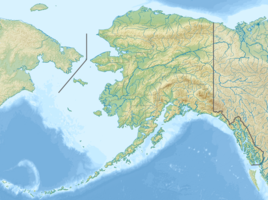Wood-Tikchik State Park
|
Tikchik State Park
|
||
| location | Alaska (USA) | |
| surface | 6475 km² | |
| Geographical location | 59 ° 45 ′ N , 158 ° 45 ′ W | |
|
|
||
| Setup date | 1978 | |
| administration | Division of Parks and Outdoor Recreation, Alaska Dept. of Natural Resources |
|
The Wood-Tikchik State Park in western Alaska was founded in 1978 and is square kilometers with 6475, which is roughly the size of Delaware corresponds to the largest State Park from Alaska and one of the largest in the United States .
The park is north of Dillingham on the eastern flank of the Wood River Mountains , a range of the Kuskokwim Mountains . It includes a number of larger glacial lakes such as Lake Nerka , Lake Beverley , Lake Kulik , Nuyakuk Lake or Chikuminuk Lake . It is named after the Wood River and Tikchik Lake . In the west, the state park borders the Togiak National Wildlife Refuge , in the east lies the Nushagak River plain .
The Togiak NWR and the Yukon Delta National Wildlife Refuge adjoining it to the west together with the Wood-Tikchik State Park form a contiguous protected area with around 98,400 km², which is roughly the size of Hungary .
The park is located in the transition zone from coniferous forest to tundra . White spruce and birch grow up to an altitude of around 300 m, above which are moors, heathland, alpine meadows and bare rock.
All five species of Pacific salmon are found in the park's waters. Moose , caribou and brown bears live in the entire park, black bears are only found in smaller populations in the northern and eastern parts. In addition to many species of waterfowl , bald eagles , golden eagles , arctic terns and plovers have a habitat here.
